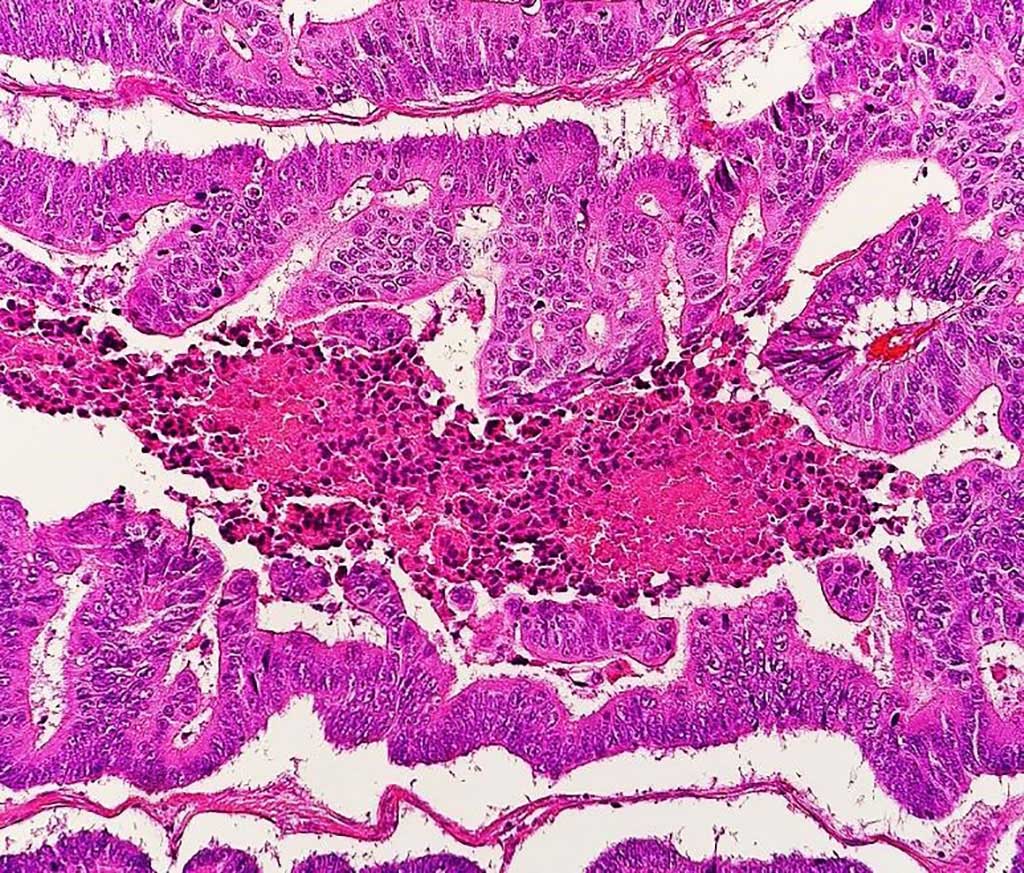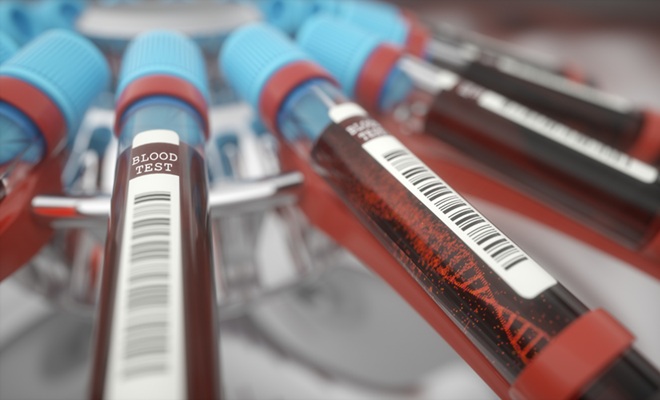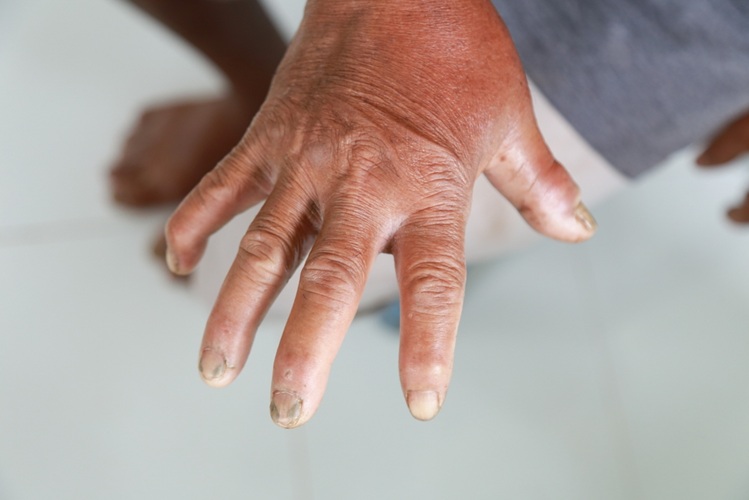Blood Test Detects Early Colorectal Adenomas
|
By LabMedica International staff writers Posted on 08 Feb 2021 |

Image: Photomicrograph of a moderately differentiated colorectal carcinoma with dirty necrosis (Photo courtesy of Mikael Häggström, MD).
Colonoscopies are the gold standard for screening but have low compliance rates due to the invasiveness of the procedure. Stool-based tests have poor compliance and low sensitivity for advanced adenomas (AA), at about 24% to 42%.
Many of the 50,000 annual colorectal cancer (CRC) deaths can be attributed to 1/3 eligible Americans not following screening guidelines or approximately 1/2 of the population not adherent to the follow-up post-polypectomy guidelines. The new understanding of the natural history and shared etiology of adenomas and CRC inform integration of clinically relevant biomarkers.
Medical Scientists at the Stanford University Medical Center (Stanford, CA, USA) and their colleagues conducted a prospective, blinded study of 458 individuals who had their blood drawn prior to undergoing colonoscopy and who had no prior history of colorectal cancer. Of them, 239 individuals underwent screening colonoscopy and 219 underwent surveillance colonoscopy. Most of the individuals (86%) were asymptomatic, whereas 14% had symptoms or a positive fecal immunochemical test.
The team developed the FirstSight blood test (CellMax Life, Sunnyvale, CA, USA) to detect adenoma-carcinoma pathways in blood samples based on the presence of circulating gastrointestinal epithelial cells and somatic mutations of cell-free tumor DNA. The test analyzes two biomarkers: circulating gastrointestinal epithelial cells and somatic mutations of cell-free DNA. The probability of advanced neoplasia was obtained by ordinal/nominal logistic regression methods together with SEER-incidence rate and prior history of AA on a training set of 346 subjects. A cutpoint was selected to obtain a test specificity (non-neoplastic finding or negative colonoscopy) of 90% resulting in a sensitivity of 100% and 80.0% for detection of CRC and advanced neoplasia (AN = CRC+AA), respectively, on the training subjects.
The investigators reported that the area under the ROC curve is 0.91. Validation using the fixed cutpoint and 112 test subjects achieved 91.4% specificity and 100% and 75.0% sensitivity for CRC and AN. Shai Friedland, MD, a Professor of Gastroenterology and his colleagues concluded that “This blood test has high sensitivity for colorectal advanced neoplasia while retaining high specificity. The quantitative nature of the score has the potential to enable prognostic stratification of patients for screening or post-polypectomy surveillance colonoscopy.” The study was presented at the Gastrointestinal Cancers Symposium (virtual meeting); held January 15-17, 2021.
Related Links:
Stanford University Medical Center
CellMax Life
Many of the 50,000 annual colorectal cancer (CRC) deaths can be attributed to 1/3 eligible Americans not following screening guidelines or approximately 1/2 of the population not adherent to the follow-up post-polypectomy guidelines. The new understanding of the natural history and shared etiology of adenomas and CRC inform integration of clinically relevant biomarkers.
Medical Scientists at the Stanford University Medical Center (Stanford, CA, USA) and their colleagues conducted a prospective, blinded study of 458 individuals who had their blood drawn prior to undergoing colonoscopy and who had no prior history of colorectal cancer. Of them, 239 individuals underwent screening colonoscopy and 219 underwent surveillance colonoscopy. Most of the individuals (86%) were asymptomatic, whereas 14% had symptoms or a positive fecal immunochemical test.
The team developed the FirstSight blood test (CellMax Life, Sunnyvale, CA, USA) to detect adenoma-carcinoma pathways in blood samples based on the presence of circulating gastrointestinal epithelial cells and somatic mutations of cell-free tumor DNA. The test analyzes two biomarkers: circulating gastrointestinal epithelial cells and somatic mutations of cell-free DNA. The probability of advanced neoplasia was obtained by ordinal/nominal logistic regression methods together with SEER-incidence rate and prior history of AA on a training set of 346 subjects. A cutpoint was selected to obtain a test specificity (non-neoplastic finding or negative colonoscopy) of 90% resulting in a sensitivity of 100% and 80.0% for detection of CRC and advanced neoplasia (AN = CRC+AA), respectively, on the training subjects.
The investigators reported that the area under the ROC curve is 0.91. Validation using the fixed cutpoint and 112 test subjects achieved 91.4% specificity and 100% and 75.0% sensitivity for CRC and AN. Shai Friedland, MD, a Professor of Gastroenterology and his colleagues concluded that “This blood test has high sensitivity for colorectal advanced neoplasia while retaining high specificity. The quantitative nature of the score has the potential to enable prognostic stratification of patients for screening or post-polypectomy surveillance colonoscopy.” The study was presented at the Gastrointestinal Cancers Symposium (virtual meeting); held January 15-17, 2021.
Related Links:
Stanford University Medical Center
CellMax Life
Latest Pathology News
- New Error-Corrected Method to Help Detect Cancer from Blood Samples Alone
- "Metal Detector" Algorithm Hunts Down Vulnerable Tumors
- Novel Technique Uses ‘Sugar’ Signatures to Identify and Classify Pancreatic Cancer Cell Subtypes
- Advanced Imaging Reveals Mechanisms Causing Autoimmune Disease
- AI Model Effectively Predicts Patient Outcomes in Common Lung Cancer Type
- AI Model Predicts Patient Response to Bladder Cancer Treatment
- New Laser-Based Method to Accelerate Cancer Diagnosis
- New AI Model Predicts Gene Variants’ Effects on Specific Diseases
- Powerful AI Tool Diagnoses Coeliac Disease from Biopsy Images with Over 97% Accuracy
- Pre-Analytical Conditions Influence Cell-Free MicroRNA Stability in Blood Plasma Samples
- 3D Cell Culture System Could Revolutionize Cancer Diagnostics
- Painless Technique Measures Glucose Concentrations in Solution and Tissue Via Sound Waves
- Skin-Based Test to Improve Diagnosis of Rare, Debilitating Neurodegenerative Disease
- Serum Uromodulin Could Indicate Acute Kidney Injury in COVID-19 Patients
- AI Model Reveals True Biological Age From Five Drops of Blood
- First-Of-Its-Kind AI Tool Visualizes Cell’s ‘Social Network’ To Treat Cancer
Channels
Clinical Chemistry
view channel
New Method Uses Pulsed Infrared Light to Find Cancer's 'Fingerprints' In Blood Plasma
Cancer diagnoses have traditionally relied on invasive or time-consuming procedures like tissue biopsies. Now, new research published in ACS Central Science introduces a method that utilizes pulsed infrared... Read more
Carbon Nanotubes Help Build Highly Accurate Sensors for Continuous Health Monitoring
Current sensors can measure various health indicators, such as blood glucose levels, in the body. However, there is a need to develop more accurate and sensitive sensor materials that can detect lower... Read moreMolecular Diagnostics
view channel
Gene-Based Blood Test Accurately Predicts Tumor Recurrence of Advanced Skin Cancer
Melanoma, an aggressive form of skin cancer, becomes extremely difficult to treat once it spreads to other parts of the body. For patients with metastatic melanoma tumors that cannot be surgically removed... Read more
Blood Test Could Identify Patients at Risk for Severe Scleroderma
Systemic sclerosis, also known as scleroderma, causes the hardening of the skin and connective tissues. In many cases, the disease can also damage vital organs, including the heart, kidneys, lungs, and... Read moreHematology
view channel
New Scoring System Predicts Risk of Developing Cancer from Common Blood Disorder
Clonal cytopenia of undetermined significance (CCUS) is a blood disorder commonly found in older adults, characterized by mutations in blood cells and a low blood count, but without any obvious cause or... Read more
Non-Invasive Prenatal Test for Fetal RhD Status Demonstrates 100% Accuracy
In the United States, approximately 15% of pregnant individuals are RhD-negative. However, in about 40% of these cases, the fetus is also RhD-negative, making the administration of RhoGAM unnecessary.... Read moreImmunology
view channel
Stem Cell Test Predicts Treatment Outcome for Patients with Platinum-Resistant Ovarian Cancer
Epithelial ovarian cancer frequently responds to chemotherapy initially, but eventually, the tumor develops resistance to the therapy, leading to regrowth. This resistance is partially due to the activation... Read more
Machine Learning-Enabled Blood Test Predicts Immunotherapy Response in Lymphoma Patients
Chimeric antigen receptor (CAR) T-cell therapy has emerged as one of the most promising recent developments in the treatment of blood cancers. However, over half of non-Hodgkin lymphoma (NHL) patients... Read moreMicrobiology
view channel
Handheld Device Delivers Low-Cost TB Results in Less Than One Hour
Tuberculosis (TB) remains the deadliest infectious disease globally, affecting an estimated 10 million people annually. In 2021, about 4.2 million TB cases went undiagnosed or unreported, mainly due to... Read more
New AI-Based Method Improves Diagnosis of Drug-Resistant Infections
Drug-resistant infections, particularly those caused by deadly bacteria like tuberculosis and staphylococcus, are rapidly emerging as a global health emergency. These infections are more difficult to treat,... Read more
Breakthrough Diagnostic Technology Identifies Bacterial Infections with Almost 100% Accuracy within Three Hours
Rapid and precise identification of pathogenic microbes in patient samples is essential for the effective treatment of acute infectious diseases, such as sepsis. The fluorescence in situ hybridization... Read moreTechnology
view channel
Pain-On-A-Chip Microfluidic Device Determines Types of Chronic Pain from Blood Samples
Chronic pain is a widespread condition that remains difficult to manage, and existing clinical methods for its treatment rely largely on self-reporting, which can be subjective and especially problematic... Read more
Innovative, Label-Free Ratiometric Fluorosensor Enables More Sensitive Viral RNA Detection
Viruses present a major global health risk, as demonstrated by recent pandemics, making early detection and identification essential for preventing new outbreaks. While traditional detection methods are... Read moreIndustry
view channel
Cepheid and Oxford Nanopore Technologies Partner on Advancing Automated Sequencing-Based Solutions
Cepheid (Sunnyvale, CA, USA), a leading molecular diagnostics company, and Oxford Nanopore Technologies (Oxford, UK), the company behind a new generation of sequencing-based molecular analysis technologies,... Read more
Grifols and Tecan’s IBL Collaborate on Advanced Biomarker Panels
Grifols (Barcelona, Spain), one of the world’s leading producers of plasma-derived medicines and innovative diagnostic solutions, is expanding its offer in clinical diagnostics through a strategic partnership... Read more























